It looks like you're using an Ad Blocker.
Please white-list or disable AboveTopSecret.com in your ad-blocking tool.
Thank you.
Some features of ATS will be disabled while you continue to use an ad-blocker.
share:
Strange Moons: Mimas....."That's No Moon!"
Mimas was first dicovered by William Herschel in 1789. From that time until Voyager 1 passed by Saturn, it was simply the 7th moon that had been discovered, and a white dot in astronomer's telescope.
Voyager 1 passed by and imaged Mimas in November, 1980:

The first published pictures of it had everyone joking about it, because of a very good resembelance to a certain fictional piece of movie mania from "Star Wars":
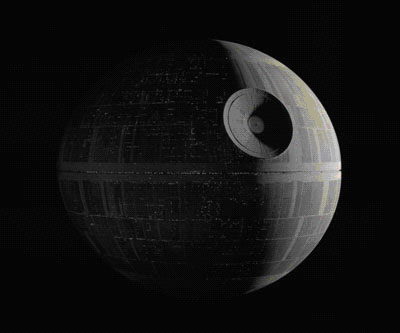
"That's no moon! It's a space station." - Obi-Wan, Star Wars: A New Hope
Before we go into that distinct feature on Mimas, first a bit of information about it:
Mimas is only about 415 km wide. Quite small when compared to our own moon.
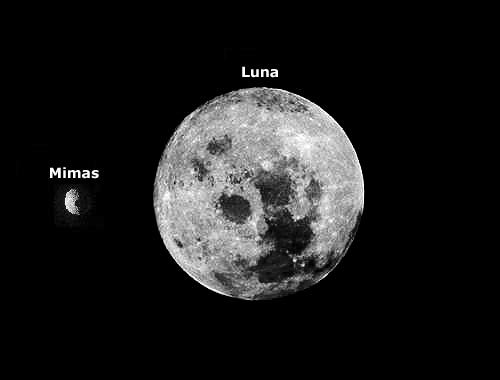
It has the same surface area as the country of Spain, and has a low density, 1.15 g/cm^3, meaning it's made up mostly of water with a little bit of rock thrown in.
When the Saturn probe Cassini arrived, it has taken very high resolution images of Mimas:

Some Trivia: Mimas is not actually round, it's more egg shaped, and it's exact dimensions are 415.6 × 393.4 × 381.2 km. The original Death Star from "Star Wars" is only about 140 km wide. So as small as Mimas is, it's still over 3 times larger than the dreaded Death Star.
The most prominant feature of Mimas is Herschel Crater, that looks like the large dish on the Death Star:
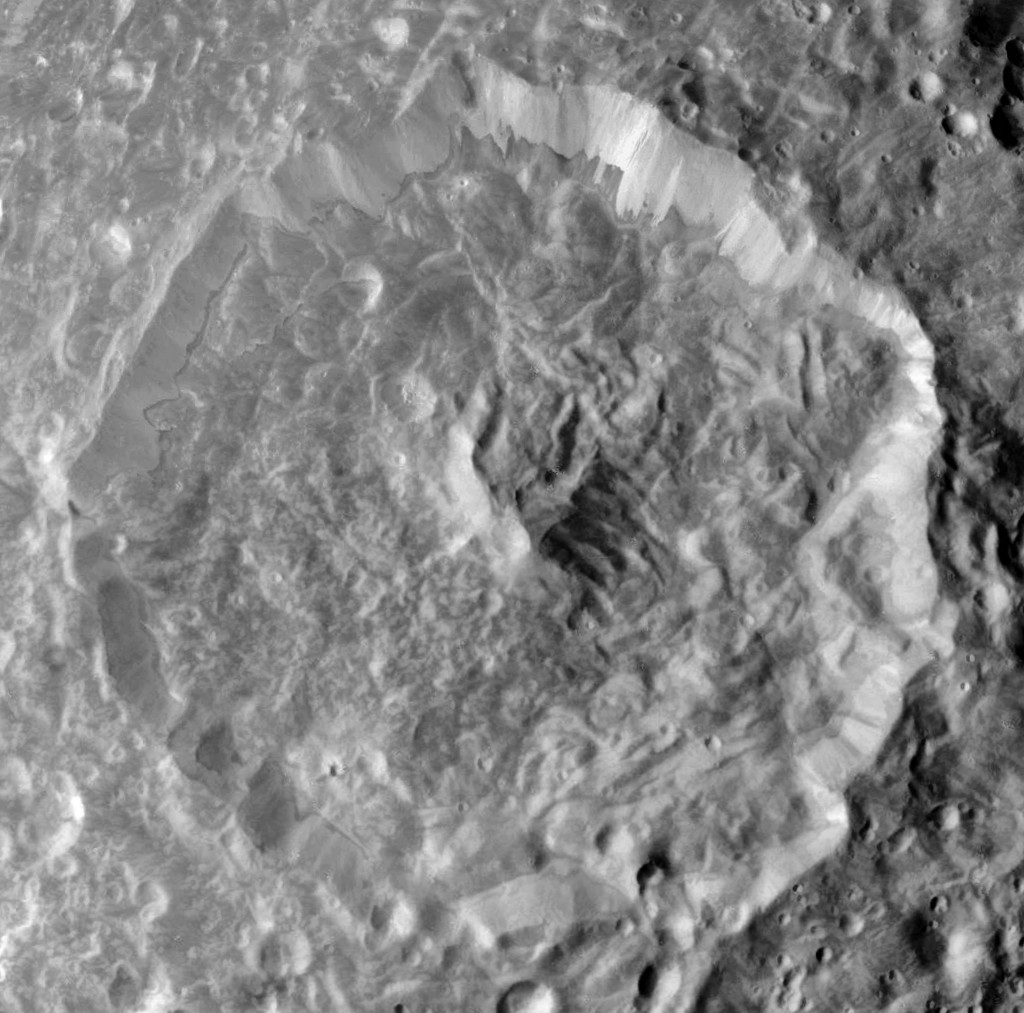
Herschel is 130 km across.
Here's an even closer view of the crater sides. I love how the material has cascaded down the sides of the crater:
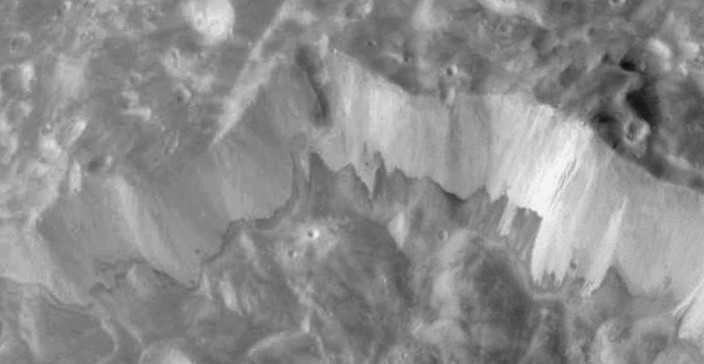
As strange as Mimas looks with that large crater, the interesting thing is how many of Saturn's moons also have very large prominant craters:
Dione:
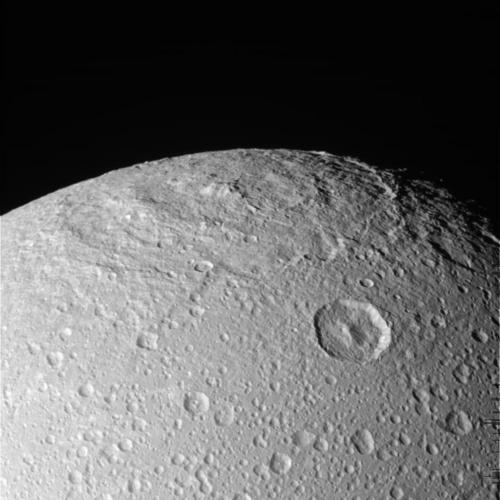
Tethys:
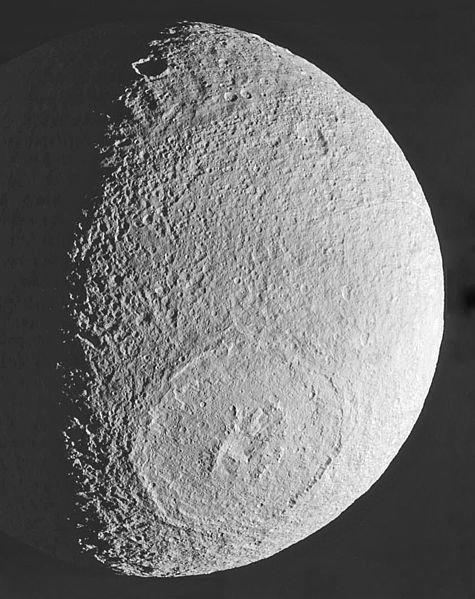
Hyperion:
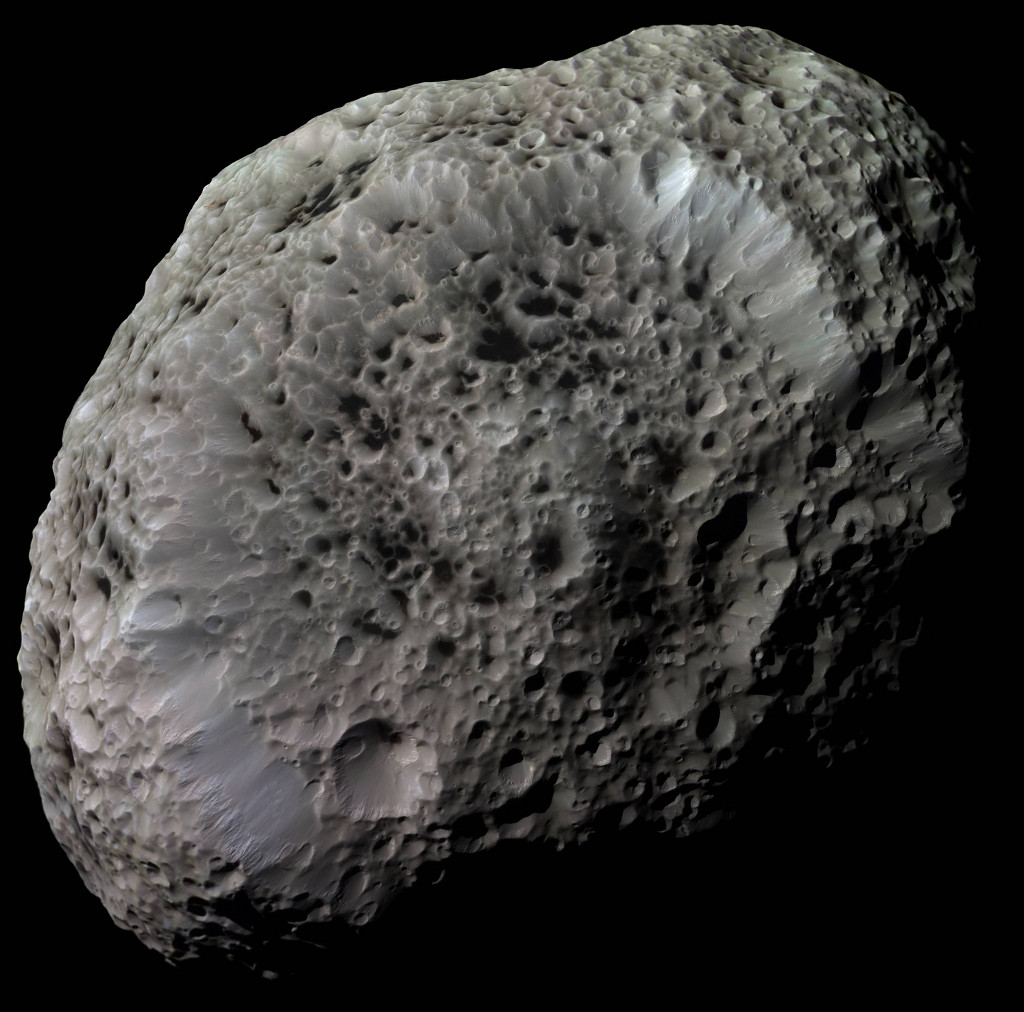
And Iapetus sports 4 massive ones:


Of course all that tells us is that the solar system was a very violent place during it's first days, and many of these features are ancient.
Saturn's moons do not hold a monopoly of impressive craters. Check out Callisto, one of Jupiter's largest moons:

The multiple rings remind me of a car windshield that got hit with a baseball......
What makes these craters look so impressive is their size as compared to the size of the body they are on.
For example, Herschel crater on Mimas looks darn impressive, but at only 130 km, it's smaller than the impact crater Chicxulub that hit the Earth 65 million years ago, which is 180 km wide!
Still, Herschel looks impressive because of the size ratio to the moon. In order for our planet, Earth to have a crater that had the same ratio, we would need a crater the same size as Australia!
So what are the largest craters in our solar system? I'll give you the top 3. These are what we call "Confirmed" craters, meaning that astronomers agree they were formed by impacts:
Number 3: Hellas Planitia, Mars

Hellas Planitia measures in at 2,300 km wide. The basin floor measures at 7,152 meters deep. That is so deep, that scientist think it just might have enough air pressure at it's bottom for liquid water to exist, given the right conditions.
Number 2: South Pole-Aitken Basin, Earth's Moon
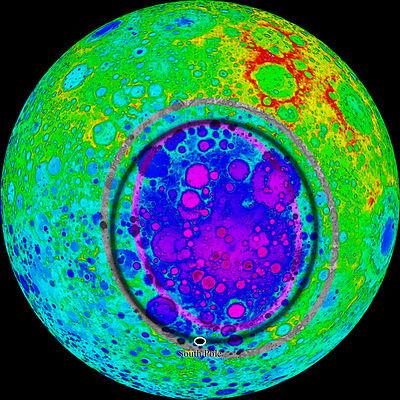
Aitken Basin measures in at 2,500 km wide.
Number 1: Utopia Planitia, Mars
The largest confirmed and recognized crater in the solar system (at this time), is on the planet Mars:
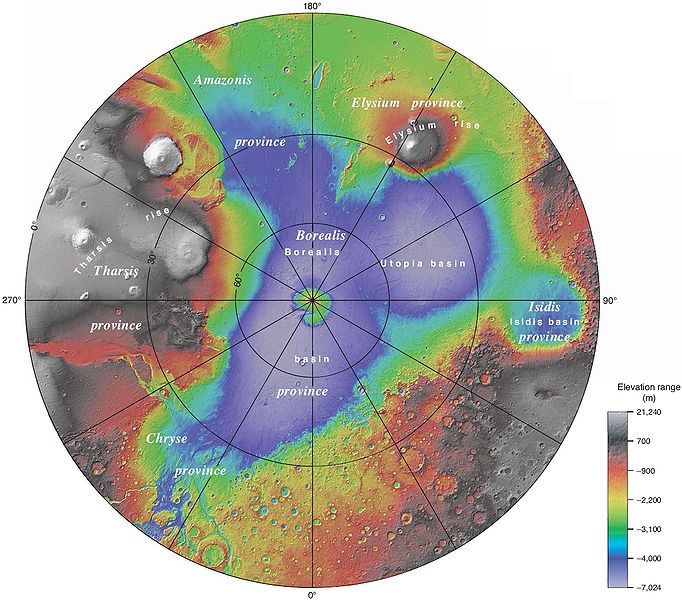
The Utopia Basin measures in at a whopping 3,300 km! That's a 49% crater to body ratio. It's also where the Viking 2 lander touched down.
Trivia Note: in the Star Trek universe, Utopia Planitia is part of the ship building facility that built the original Enterprise, Enterprise-D and F, and also the USS Voyager.
Okay, so what is the largest "unconfirmed" crater in the Solar system?
That again, goes to Mars. The entire North Polar Basin is theorized to be a impact crater:
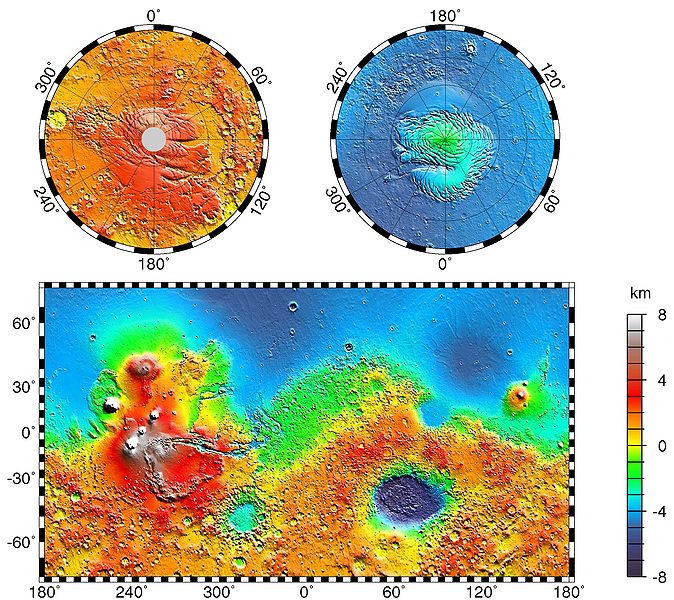
The enitre top half of that flat map in the picture above is thought to be a impact basin over 10,600 km wide. Wow, Mars has had a rough time in the past. Again, however, it's just a theory and has yet to be confirmed.
What about our planet? What's the biggest crater that we can still see?
That would be Vredefort Dome, in South Africa:
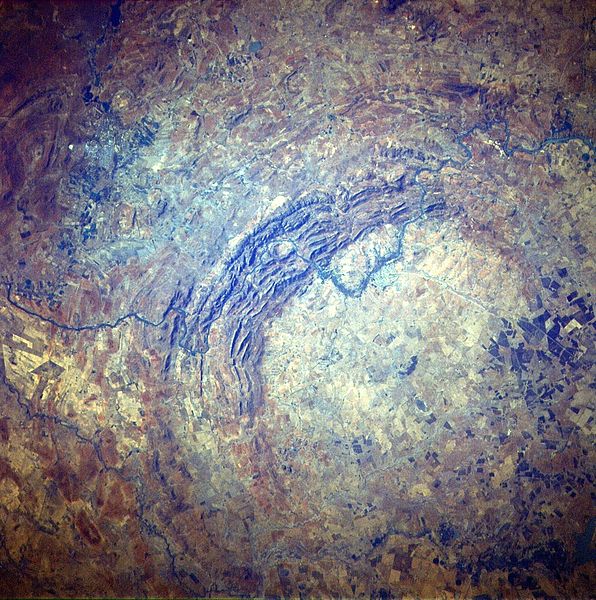
It's an impact crater up to 300 km wide. It was made just over 2 billion years ago. Earth may of had larger, but weather, erosion and geology erase a lot of impact craters here on Earth.
So while Herschel on Mimas is impressive looking........Mars is actually King of the Craters....
edit on 19-9-2013 by eriktheawful because: (no reason given)
Very informative and a good dose of perspective for those of us who see various postings on ATS regarding moons but don't have the drive to research
them further.
Thanks for sharing!
Thanks for sharing!
Impacts like the utopia basin might explain what happen mars atmosphere and water.
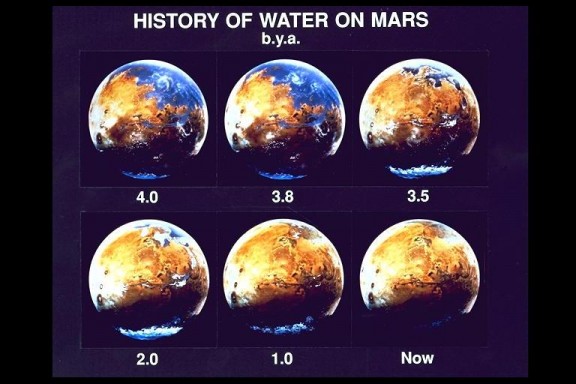
without the mass/gravity to pull it back in it just got launch in to space.
Poor little mars

without the mass/gravity to pull it back in it just got launch in to space.
Poor little mars
reply to post by eriktheawful
Great facts about craters and moons! I enjoyed this. You would think Earth would feature the largest impact craters being the largest confirmed solid surface planet in our solar system.
Great facts about craters and moons! I enjoyed this. You would think Earth would feature the largest impact craters being the largest confirmed solid surface planet in our solar system.
I knew mars had some serious craters but i never knew it was the king! [/Elvis voice]
I always learn from and enjoy your strange moon threads. I look forward to the next one.
I always learn from and enjoy your strange moon threads. I look forward to the next one.
I've been enjoying your Strange moon series!
A couple of my Faves are:
The one that orbits Neptune backwards, Triton
and the Walnut Moon, Lapetus
and the small body Ceres deserves a gander in your series. Could be a lost moon.
Great Work!
adding:
very cool!
Those are some serious dents! Planets need good insurance!!
A couple of my Faves are:
The one that orbits Neptune backwards, Triton
and the Walnut Moon, Lapetus
and the small body Ceres deserves a gander in your series. Could be a lost moon.
Great Work!
adding:
very cool!
Those are some serious dents! Planets need good insurance!!
edit on 20-9-2013 by AbleEndangered because: addition
reply to post by eriktheawful
Iapetus is the one that has fascinated me for some time now. Talk about a "death star" moon! I saw one picture, with the light around it, that showed flat edges. You can see it here - NASA link
...and here is the picture -

Strange moon, that one.
Iapetus is the one that has fascinated me for some time now. Talk about a "death star" moon! I saw one picture, with the light around it, that showed flat edges. You can see it here - NASA link
...and here is the picture -

Strange moon, that one.
AbleEndangered
I've been enjoying your Strange moon series!
A couple of my Faves are:
The one that orbits Neptune backwards, Triton
and the Walnut Moon, Lapetus
and the small body Ceres deserves a gander in your series. Could be a lost moon.
Great Work!
adding:
very cool!
Those are some serious dents! Planets need good insurance!!edit on 20-9-2013 by AbleEndangered because: addition
Unfortunately the best images we have of Ceres right now is this from Hubble:

That will be changing here in 2015 when the Dawn space probe arrives at Ceres in Feb. that year.
LadyGreenEyes
reply to post by eriktheawful
Iapetus is the one that has fascinated me for some time now. Talk about a "death star" moon! I saw one picture, with the light around it, that showed flat edges. You can see it here - NASA link
...and here is the picture -
Strange moon, that one.
My last thread was about Iapetus:
Strange Moons: Iapetus......Walnut In Space
eriktheawful
Unfortunately the best images we have of Ceres right now is this from Hubble:
ESO's VLT telescopes are almost 3.5 times larger than the Hubble (at 8.2 meters each). Although their images are taken through the atmosphere, I think VLT could produce a better image of Ceres, would you agree?
wildespace
eriktheawful
Unfortunately the best images we have of Ceres right now is this from Hubble:
ESO's VLT telescopes are almost 3.5 times larger than the Hubble (at 8.2 meters each). Although their images are taken through the atmosphere, I think VLT could produce a better image of Ceres, would you agree?
More than likely it can.
Problem is the time spent on it taking that image. As you know, telescopes like Hubble and VLT have astronomers fighting over the time usage of them for their projects. As Dawn will be at Ceres in 2015, it may be that astronomers figure the time spent on VLT is better spent with other objects to view, since nothing beats having a HD camera up close and personal with an object.
AMAZING pics, Im somewhat taken back by the resolution of the moon.
Strange that each of the moons of saturn have a large impact crater in almost the the same position on each moon, Hmm
Strange that each of the moons of saturn have a large impact crater in almost the the same position on each moon, Hmm
Glassbender777
AMAZING pics, Im somewhat taken back by the resolution of the moon.
Strange that each of the moons of saturn have a large impact crater in almost the the same position on each moon, Hmm
Okay you have me intrigued.....What do you mean by this?
SasquatchHunter
reply to post by eriktheawful
You would think Earth would feature the largest impact craters being the largest confirmed solid surface planet in our solar system.
I am unsure if I am stupid, ignorant, confused, or you were not complete in that statement.
Can you elaborate?
Excellent threads,very interesting indeed. Ceres seems to have an atmosphere?
P.s. is there any other moons which we have few if any images?
P.s. is there any other moons which we have few if any images?
HanzHenry
SasquatchHunter
reply to post by eriktheawful
You would think Earth would feature the largest impact craters being the largest confirmed solid surface planet in our solar system.
I am unsure if I am stupid, ignorant, confused, or you were not complete in that statement.
Can you elaborate?
I don't have enough information to answer your question, an attempt would be pure speculation I'm afraid. Can you be more specific with your question regarding my initial post. Thanks.
SasquatchHunter
HanzHenry
SasquatchHunter
reply to post by eriktheawful
You would think Earth would feature the largest impact craters being the largest confirmed solid surface planet in our solar system.
I am unsure if I am stupid, ignorant, confused, or you were not complete in that statement.
Can you elaborate?
I don't have enough information to answer your question, an attempt would be pure speculation I'm afraid. Can you be more specific with your question regarding my initial post. Thanks.
Earth largest surface area in the solar system..
What do you mean?
HanzHenry
SasquatchHunter
HanzHenry
SasquatchHunter
reply to post by eriktheawful
You would think Earth would feature the largest impact craters being the largest confirmed solid surface planet in our solar system.
I am unsure if I am stupid, ignorant, confused, or you were not complete in that statement.
Can you elaborate?
I don't have enough information to answer your question, an attempt would be pure speculation I'm afraid. Can you be more specific with your question regarding my initial post. Thanks.
Earth largest surface area in the solar system..
What do you mean?
Earths largest *confirmed *solid surface area is what I said.
Jupiter, Saturn, Uranus, and Neptune are all gas giants. Mercury, Venus, Earth, and Mars all have solid surfaces of those 4 Earth being the largest one.
symptomoftheuniverse
Excellent threads,very interesting indeed. Ceres seems to have an atmosphere?
P.s. is there any other moons which we have few if any images?
All the moons of Uranus and Neptune were have been imaged by Voyager 2 only. And Voyager 2 did a flyby, so there are no where near the amount of images taken of those moons as compared to the moons of Jupiter and Saturn, which had later probes placed in orbits around those planets and plenty of time to image each and every moon around those 2 planets.
Pluto's moons (along with Pluto itself) are very fuzzy images from Hubble showing hardly any detail at all. That will change when New Horizons does it's flyby of Pluto in July 2015, and takes images of Pluto and it's moons from up close.
SasquatchHunter
HanzHenry
SasquatchHunter
HanzHenry
SasquatchHunter
reply to post by eriktheawful
You would think Earth would feature the largest impact craters being the largest confirmed solid surface planet in our solar system.
I am unsure if I am stupid, ignorant, confused, or you were not complete in that statement.
Can you elaborate?
I don't have enough information to answer your question, an attempt would be pure speculation I'm afraid. Can you be more specific with your question regarding my initial post. Thanks.
Earth largest surface area in the solar system..
What do you mean?
Earths largest *confirmed *solid surface area is what I said.
Jupiter, Saturn, Uranus, and Neptune are all gas giants. Mercury, Venus, Earth, and Mars all have solid surfaces of those 4 Earth being the largest one.
Actually, that's not quite true.
If we remove all the oceans of the Earth, then the land surface area of 510,072,000 km^2, and you would be right.
But planetary scientist count the oceans as a liquid surface. Because of that, and because the Earth is covered by 70.8% with water, they consider Earth to only have 148,940,000 km^2 surface area of land.
Venus on the other hand, has a surface area of 460,000,000 km^2 and no liquid water covering that solid land (way too hot for liquid water to exist).
So technically, planetary scientist say that Venus has the largest surface area of exposed land of any planet in our solar system.
new topics
-
Is the origin for the Eye of Horus the pineal gland?
General Conspiracies: 1 hours ago -
Man sets himself on fire outside Donald Trump trial
Mainstream News: 1 hours ago -
Biden says little kids flip him the bird all the time.
2024 Elections: 1 hours ago -
The Democrats Take Control the House - Look what happened while you were sleeping
US Political Madness: 2 hours ago -
Sheetz facing racial discrimination lawsuit for considering criminal history in hiring
Social Issues and Civil Unrest: 2 hours ago -
In an Historic First, In N Out Burger Permanently Closes a Location
Mainstream News: 4 hours ago -
MH370 Again....
Disaster Conspiracies: 4 hours ago -
Are you ready for the return of Jesus Christ? Have you been cleansed by His blood?
Religion, Faith, And Theology: 6 hours ago -
Chronological time line of open source information
History: 8 hours ago -
A man of the people
Medical Issues & Conspiracies: 9 hours ago
top topics
-
In an Historic First, In N Out Burger Permanently Closes a Location
Mainstream News: 4 hours ago, 14 flags -
The Democrats Take Control the House - Look what happened while you were sleeping
US Political Madness: 2 hours ago, 8 flags -
A man of the people
Medical Issues & Conspiracies: 9 hours ago, 8 flags -
Thousands Of Young Ukrainian Men Trying To Flee The Country To Avoid Conscription And The War
Other Current Events: 14 hours ago, 7 flags -
Iran launches Retalliation Strike 4.18.24
World War Three: 17 hours ago, 6 flags -
4 plans of US elites to defeat Russia
New World Order: 11 hours ago, 4 flags -
Man sets himself on fire outside Donald Trump trial
Mainstream News: 1 hours ago, 4 flags -
12 jurors selected in Trump criminal trial
US Political Madness: 17 hours ago, 4 flags -
Biden says little kids flip him the bird all the time.
2024 Elections: 1 hours ago, 3 flags -
Sheetz facing racial discrimination lawsuit for considering criminal history in hiring
Social Issues and Civil Unrest: 2 hours ago, 3 flags
active topics
-
12 jurors selected in Trump criminal trial
US Political Madness • 76 • : matafuchs -
Israeli Missile Strikes in Iran, Explosions in Syria + Iraq
World War Three • 101 • : CarlLaFong -
The Democrats Take Control the House - Look what happened while you were sleeping
US Political Madness • 16 • : VariedcodeSole -
Thousands Of Young Ukrainian Men Trying To Flee The Country To Avoid Conscription And The War
Other Current Events • 26 • : Lazy88 -
Biden says little kids flip him the bird all the time.
2024 Elections • 6 • : Astrocometus -
George Knapp AMA on DI
Area 51 and other Facilities • 27 • : TheValeyard -
Man sets himself on fire outside Donald Trump trial
Mainstream News • 12 • : xuenchen -
4 plans of US elites to defeat Russia
New World Order • 35 • : Oldcarpy2 -
Sheetz facing racial discrimination lawsuit for considering criminal history in hiring
Social Issues and Civil Unrest • 6 • : chiefsmom -
Is the origin for the Eye of Horus the pineal gland?
General Conspiracies • 1 • : ARM19688
